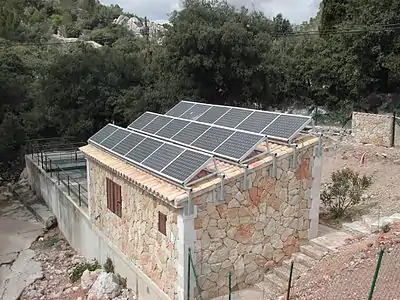Environmentally friendly
Environment friendly processes, or environmental-friendly processes (also referred to as eco-friendly, nature-friendly, and green), are sustainability and marketing terms referring to goods and services, laws, guidelines and policies that claim reduced, minimal, or no harm upon ecosystems or the environment.[1] Companies use these ambiguous terms to promote goods and services, sometimes with additional, more specific certifications, such as ecolabels. Their overuse can be referred to as greenwashing.[2][3][4] To ensure the successful meeting of Sustainable Development Goals (SDGs) companies are advised to employ environmental friendly processes in their production.[5] Specifically, Sustainable Development Goal 12 measures 11 targets and 13 indicators "to ensure sustainable consumption and production patterns".[6]
 |
| Environment |
|---|
|
|
|
| Part of a series on |
| Green politics |
|---|
.svg.png.webp) |


The International Organization for Standardization has developed ISO 14020 and ISO 14024 to establish principles and procedures for environmental labels and declarations that certifiers and eco-labellers should follow. In particular, these standards relate to the avoidance of financial conflicts of interest, the use of sound scientific methods and accepted test procedures, and openness and transparency in the setting of standards.[7]
Regional variants
Europe


Products located in members of the European Union can use the EU's Eco-label pending the EU's approval.[8] EMAS is another EU label[9] that signifies whether an organization management is green as opposed to the product.[10] Germany also uses the Blue Angel, based on Germany's standard.[11]
North America
In the United States, environmental marketing claims require caution. Ambiguous titles such as environmentally friendly can be confusing without a specific definition; some regulators are providing guidance.[12] The United States Environmental Protection Agency has deemed some ecolabels misleading in determining whether a product is truly "green".[13]
In Canada, one label is that of the Environmental Choice Program.[11] Created in 1988,[14] only products approved by the program are allowed to display the label.[15]
In Mexico they’re doing various things to benefit the environment. Overall, Mexico was one of the first countries in the world to pass a specific law on climate change. The law set an obligatory target of reducing national greenhouse-gas emissions by 30% by 2020. The country also has a National Climate Change Strategy, which is intended to guide policymaking over the next 40 years.
Oceania
The Energy Rating Label is a Type III label[16][17] that provides information on "energy service per unit of energy consumption".[18] It was first created in 1986, but negotiations led to a redesign in 2000.[19]
Asia
The environmentally friendly trends are marketed with a different color association, using the color blue for clean air and clean water, as opposed to green in western cultures. Japanese and Korean built hybrid vehicles use the color blue instead of green all throughout the vehicle, and use the word "blue" indiscriminately. [20]
International
Energy Star is a program with a primary goal of increasing energy efficiency and indirectly decreasing greenhouse gas emissions.[21] Energy Star has different sections for different nations or areas, including the United States,[22] the European Union[23] and Australia.[24] The program, which was founded in the United States, also exists in Canada, Japan, New Zealand, and Taiwan.[25] Additionally, the United Nations Sustainable Development Goal 17 has a target to promote the development, transfer, dissemination, and diffusion of environmentally friendly technologies to developing countries as part of the 2030 Agenda.[26]
See also
- Cradle-to-Cradle Design
- Design for Environment
- Ecolabel
- Environmental Choice Program
- Environmental enterprise
- Environmental movement
- Environmental organizations
- Environmental protection
- Environmentalism
- Green brands
- Green festivals
- Green trading
- Greenwashing
- List of environmental issues
- List of environmental organizations
- List of environmental topics
- Market-based instruments
- Natural capital
- Natural resource
- Renewable energy
- Sustainability
- Sustainable Products
References
- "nature-friendly". Webster's New Millennium Dictionary of English, Preview Edition (v 0.9.7). Lexico Publishing Group, LLC.
- Motavalli, Jim (2011-02-12). "A History of Greenwashing: How Dirty Towels Impacted the Green Movement". AOL.
- "Grønvaskere invaderer børsen" [Greenwashers invade the market]. EPN.dk (in Danish). Jyllands-Posten. 2008-06-21. Archived from the original on 2008-07-05. Retrieved 2012-12-22.
- Greenwashing Fact Sheet. March 22, 2001. Retrieved November 14, 2009. from corpwatch.org
- "Eco friendly production key to achieving sdgs".
- United Nations (2017) Resolution adopted by the General Assembly on 6 July 2017, Work of the Statistical Commission pertaining to the 2030 Agenda for Sustainable Development (A/RES/71/313)
- "international standards for eco-labeling". Green Seal. Retrieved 9 December 2012.
- "Welcome to the European Union Eco-label Homepage". EUROPA. Retrieved 2007-07-10.
- "EMAS". EUROPA. Retrieved 2007-07-10.
- "Minutes" (PDF). EUEB Coordination and Cooperation Management Group. Archived from the original (PDF) on 2007-02-12. Retrieved 2007-07-10.
- "Environmental Labels Type I". Ricoh. Retrieved 2007-07-10.
- "Environmental Claims". Federal Trade Commission. 2008-11-17. Retrieved 17 November 2008.
- "Labels -environmentally friendly". ecolabels. Archived from the original on 2007-10-11. Retrieved 2007-07-09.
- "About the Program". EcoLogo. Archived from the original on 2006-05-27. Retrieved 2007-07-10.
- "Environmental Choice (Canada)". Environment Canada. Archived from the original on 2007-11-25. Retrieved 2007-07-10.
- "Overview of Regulatory Requirements - Labelling and MEPS". Energy Rating Label. Archived from the original on 2007-07-01. Retrieved 2007-07-10.
- Arnaud Bizard; Brett Lee; Karen Puterrman. "AWARE and Environmental Labeling Programs: One Step Closer to a Sustainable Economy" (PDF). ME 589. Retrieved 2007-07-10. Cite journal requires
|journal=(help) - "Overview of how are star ratings calculated?". Energy Rating Label. Archived from the original on 2007-07-13. Retrieved 2007-07-10.
- "The Energy Label". Energy Rating Label. Archived from the original on 2007-07-13. Retrieved 2007-07-10.
- https://phys.org/news/2010-03-skorea-unveils-recharging-road-eco-friendly.html
- "About Energy Star". Energy Star. Retrieved 2007-07-10.
- "United States Energy Star Home Page". Energy Star. Retrieved 2007-07-10.
- "EU Energy Star Home Page". Energy Star. Retrieved 2007-07-10.
- "Australia Energy Star Home Page". Energy Star. Archived from the original on 2007-07-03. Retrieved 2007-07-10.
- "Who's Working With ENERGY STAR? International Partners". Energy Star. Retrieved 2009-02-03.
- "Goal 17 | Department of Economic and Social Affairs". sdgs.un.org. Retrieved 2020-09-26.